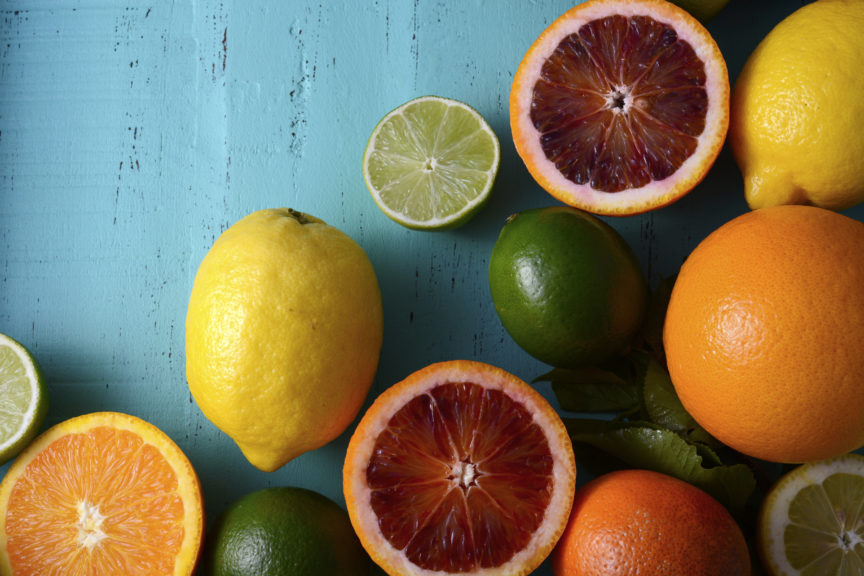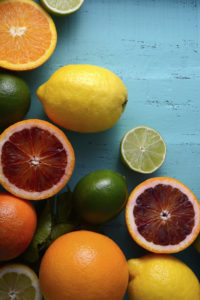 Citrus fruits are quite a big group, including oranges, lemons, limes, clemantines, tangerines, satumas, mandarins, grapefruits, and pomelos. Their zingy fresh taste is reflected in their zesty colourful outers. They are so intertwined in our culture that their colours and names of the fruits are interchangeable – orange, lemon and lime are colours commonly used in logos and marketing to grab our attention.
Citrus fruits are quite a big group, including oranges, lemons, limes, clemantines, tangerines, satumas, mandarins, grapefruits, and pomelos. Their zingy fresh taste is reflected in their zesty colourful outers. They are so intertwined in our culture that their colours and names of the fruits are interchangeable – orange, lemon and lime are colours commonly used in logos and marketing to grab our attention.
Juicy and sweet oranges make are an easily unwrapped snack, even peeling them smells great and can raise your mood. They are one of the most popular fruits in the world and are generally available from winter through summer with seasonal variations, depending on the variety.
There’s often a lot of debate about how sugary citrus fruits are. One of the main sugars in these fruits is fructose (literally fruit sugar). It is the sweetest of all naturally occurring carbohydrates. However, the sugars in the fruits need to be digested so the sugar hit is not immediate. One way to understand it is via the Glycaemic Index (GI). As a reminder, the Glycaemic Index is a scale shows how a food will affect blood sugars, if they will make them rise slowly or quickly. The higher the GI rating is, the faster the increase of sugar in the blood after eating it (a number that might change if the food is eaten in combination with another food).
However, all citrus fruits fall into the category of ‘low GI’ though within the group there are variations. Oranges have a GI around 50, lemon and grapefruit have a very low GI of around 25, so their natural sugars don’t cause a big spike in blood sugar.
If you take your citrus as a drink, such as freshly squeezed, be aware that blood sugars will rise more quickly. You’re likely to drink the equivalent of 3 or 4 oranges in a large glass of orange juice, and the body absorbs liquids faster, so the hit will be faster and higher. Stick to freshly squeezed if you can, canned and bottled drinks are often concentrated or have added sugar.
Citrus fruits are low in calories, while being able to help regulate cholesterol as they include pectin, a soluble dietary fibre which helps control blood cholesterol levels.
These colourful fruits can be little vitamin bombs, with tangerines and pink grapefruits are particularly rich in vitamin A (beta carotene) as well as potassium. The real kicker when it comes to citrus though is their vitamin C content. One good sized orange can give you around 90% of your Recommended Daily Allowance (RDA). Vitamin C is the primary water-soluble antioxidant in the body, disarming free radicals and preventing damage that can lead to cancer. A good intake of vitamin C is directly associated with a reduced risk of colon cancer.
Vitamin C is also associated with reduced severity of inflammatory conditions, such as asthma, osteoarthritis, and rheumatoid arthritis. As there is a field of thought that suggests that Type 2 diabetes is an inflammatory condition high intakes of vitamin C might help prevent it. Vitamin C is also vital for the proper function of a healthy immune system, which is why your grandma told you to have vitamin C if you had a cold. Consuming vitamin C supplements does not provide the same protective benefits as eating fresh oranges or drinking fresh juice.
Citrus fruits health benefits continue with their fibre, which has been shown to reduce high cholesterol levels. Fibre can also help keep blood sugar levels under control. Oranges are classified into two general categories—sweet and bitter—with the former being the type most commonly consumed. Popular varieties of the sweet include Valencia, Navel and Jaffa oranges, as well as the blood orange, a hybrid species that is smaller in size, more aromatic in flavor and has red hues running throughout its flesh. Bitter oranges are often used to make jam or marmalade, and their zest serves as the flavoring for liqueurs such as Grand Marnier and Cointreau.
Use grapefruit and orange segments as a delicious additions to salads this summer, and squeeze a good squirt of lemon onto any foods you fancy as, a bit like vinegar, there are some that say that it can help fight weight gain.
Nutritional content of citrus fruits
One small orange, one-half of a small grapefruit and one large tangerine are all equal to about 100 grams. You would have to eat almost two small lemons to consume 100 grams and gain the same amount of nutrients in one small orange. The numbers below refer to 100g of the fruit. The percentages are for your recommended daily allowance. None contain any fat. Grapefruit: 42 cals, 6% dietary fibre, 11g carbs (7g sugar), 23% vitamin A, 52% vitamin C.
Orange: 47 cals, 9% dietary fibre, 12g carbs (9g sugar), 88% vitamin C, 5% vitamin B-6. Lemon: 29 cals, 9g carbs (2.5% sugar) 11% dietary fibre, 88% vitamins C ,5% vitamin B-6.
Food features and recipes like this appear in the Desang Diabetes Magazine, our free-to-receive digital journal. We cover diabetes news, diabetes ‘kit’ and information on food suitable for maintaining good blood glucose control or a diabetic diet, including a regular Making Carbs Count column. It’s free! Go to the top of this page to sign up – we just need your email address. See current and past issues at
www.desang-magazine.co.uk


